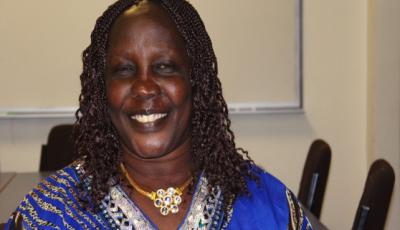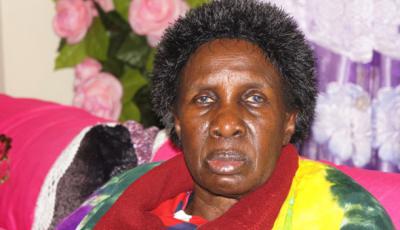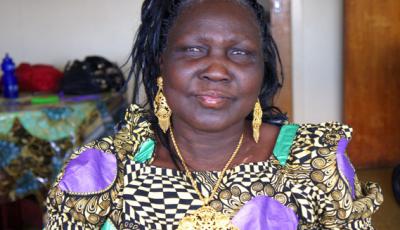Centering Orality: Exploring Gendered Wartime Violence with South Sudanese Women Elders
Posted:
Time to read:
Guest post by Sara Maher, PhD student at Monash University and member of the Border Crossing Observatory. She researches the impact of mass abduction and enslavement of South Sudanese borderlands women during the second Sudanese civil war (1983-2005). This post is part of the joint blog series on ‘Gender and Migration’ co-hosted by Border Criminologies and COMPAS. Posts in this series will be published on both blogs every Friday until the end of June.
The precursor to my PhD research was an oral history project with South Sudanese Women elders. The Anyikool Project collected over thirty hours of life stories and those recordings have now become part of the oral archive of the State Library of Victoria (Melbourne, Australia). The archive, in which women are vastly unrepresented, now includes African Australian women for the first time. The interviews will soon be made available online.
A knowledge of the recent history of South Sudan helps to contextualise these stories but this isn’t essential. All the interviews follow the same loose structure but vary greatly in content. The full spectrum of the class system is represented, from royal family to peasant farmers. About half of the participants had received some education and three had tertiary degrees. The women had been, in their former lives, farmers and teachers and nurses; a politician, a soldier, a businesswoman, and a development worker. Individually, the interviews are nuanced portraits, covering a wide range of experience, including migration to Australia. As a collection, the thirty plus hours bring to life the cultural diversity and the conflicts that are synonymous with southern Sudan in the mid to late twentieth century.

Like South Sudan itself, the South Sudanese diaspora in Australia is extraordinarily diverse: culturally, linguistically, socially, and economically. They constitute Australia’s largest minority community—of a refugee background—roughly twenty-thousand of whom reside in Victoria. Participants in the Anyikool Project represented seven different ethnic groups: Kuku, Bari, Anyuak, Chollo, Nuer, Dinka, and Acholi. Multiple sub-groups exist within these ethnic groups, but all participants, other than Bari, originate from borderlands—the Acholi and Kuku with Uganda, the Anyuak with Ethiopia, and Chollo, Dinka, and Nuer on the northern border with Sudan. Women elders are a small percentage of the South Sudanese Australian diaspora and are rarely heard beyond their community for reasons of health and age, language barriers, and isolation, yet they maintain the oral traditions of their cultures. Their stories are compelling and evocative, conveying unique accounts of a period in their country’s history that includes the introduction of missionary-run Western-style education, the end of colonialsim, and the first civil war (1956-1972), as well as an array of cultural practices including marriage, food production, and family life.

Powerful and often haunting accounts of the second civil war (1983-2005) provide new knowledge and understandings of the gendered violence these women suffered during that long war. Raids on their homes by government-backed militias, and the Sudanese Armed Forces (SAF), forced vast numbers into destitution, impoverishment, and internal displacement, and to cross borders into neighbouring countries as refugees. Famine, disease, enslavement, and genocidal violence killed over two million people and displaced more than four million.
Throughout the twenty-one years of conflict there were uncountable incidents of gendered violence. Stories of the war vary in perspective due to tribal and political affiliations but all of the women’s accounts embody survival in the face of extreme adversity. Women and children were targeted by militias and the SAF who avoided conflict with the rebel army, Sudanese Peoples Liberation Army (SPLA), and instead attacked unprotected villages with the express purpose of destroying families and livelihoods. Communities on the northern border between the Arab north and the African south were especially hard hit. The border is historically porous, contested, and hostile. For centuries African southerners have been abducted into slavery and trafficked across this border, a practice that had slowed by the end of British colonialism in the mid-1950s but remerged during the war. It has been claimed that between 1983 and 2002, up to 200,000 people, mainly women and children, were abducted and trafficked into rural and urban slavery in northern cities and neighbouring countries. It’s impossible to know how many remain enslaved. Such was the prevalence of slave trading almost all Anyikool Project participants; without prompting, many referred to or spoke of it directly. During one interview, the interpreter interjected and described their experience of being taken as a child during a raid and forced into slavery on a farm in the north until escaping months later.
Sudan’s wartime borders were often natural barriers, changeable, unpredictable, some guarded, others not. The Kirr River in the province of the Bahr el-Ghazal separated southern Sudan from the north. The Gilo River in the Gambela district of Ethiopia was the border with Sudan. Thousands of women and children fleeing violence had no choice but to cross these rivers, made dangerous by deep, fast water, armed attacks and wild animals; rarely did the crossing of these rivers lead to safety.

Those who travelled north did so believing falsely that they might find some protection in the so-called peace camps and shanties of Sudan’s capital, Khartoum. But first they had to safely cross the Kirr and make the long trek through Baggara territory with the risk of being killed, abducted, or raped by their militia. The alternative was to move east into Ethiopia via the Gilo River, another long and dangerous trek that could take months. Three refugee camps were created in Ethiopia from the mid-1980s: Dimma, Pinyudo, and Itang. Of the hundreds of thousands of refugees who filled those camps, approximately 27,000 were unaccompanied and orphaned children—a group that became known as the Lost Boys.

When the Mengistu government fell in 1991, those refugees were forced out of the camps back across the Gilo River by Ethiopian militias. A woman gave birth the night before the camp was attacked and put the newborn in a bucket, then the bucket on her head, and walked to the Gilo River with her two other small children. At the river she wove reeds into a basket, then put the children in it and crossed safely. A group of women pulled their children across in a fishing net at low tide. But many did not survive. Estimates of the number of fatalities at the Gilo River range from two to nine thousand. In most case they were children, drowned, eaten by crocodiles, or killed by militias.
The women conveyed these stories in a range of ways, including urgency, sadness, and nonchalance. One woman showed signs of traumatic distress and accepted a referral to a trauma agency. On the whole it seems that these women want to speak about that time. They remain silent only until they are asked. Being heard means their experiences are acknowledged. And that’s one of the purposes of the doctoral research the Anyikool Project led to. The other is to address the impact of slavery ten years after the war ended; to address social and cultural changes caused by the mass scale abductions. Questions are few in number and non-prescriptive, designed to encourage the orality of the participants. Fieldwork in Australia will begin in the coming weeks. Fieldwork in South Sudan will be conducted later this year. Despite a new life in a new country, South Sudanese Australians remain intensely connected to their homeland. While South Sudan achieved independence in 2011, the country hasn’t found stability or peace. A third civil war erupted in December 2013. Memories of the past had always been fresh and alive before this, but the latest conflict has torn open old wounds. All attempts to end the current conflict have failed, adding to the already profound sense of loss and injustice that already haunted the country and its diasporas.
The women elders of South Sudan have much to offer in terms of discourses on wartime gendered violence, on trafficking and slavery, and border crossings—discourses that have historically excluded women’s stories. By engaging with indigenous knowledges, social science researchers can tap a vast wealth of experience and knowing. Methodologies that centre around orality can decolonise knowledge production and lead researchers into largely unexplored territory.
Any comments about this post? Get in touch with us! Send us an email, or post a comment here or on Facebook. You can also tweet us.
__________
How to cite this blog post (Harvard style)
Maher, S. (2015) Centering Orality: Exploring Gendered Wartime Violence with South Sudanese Women Elders. Available at: http://bordercriminologies.law.ox.ac.uk/exploring-gendered-wartime-violence/ (Accessed [date]).
Share:








